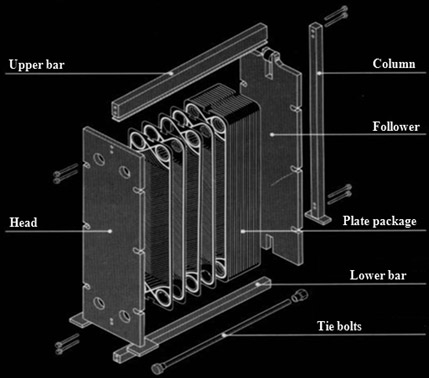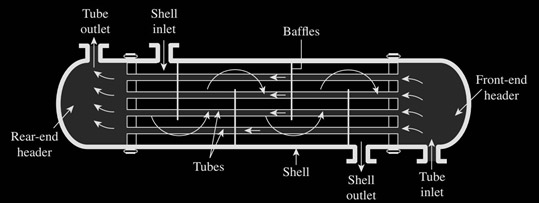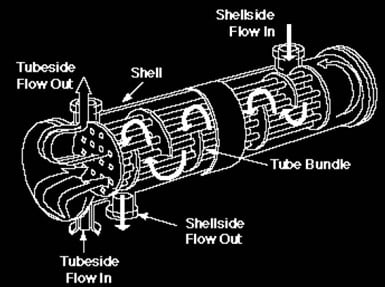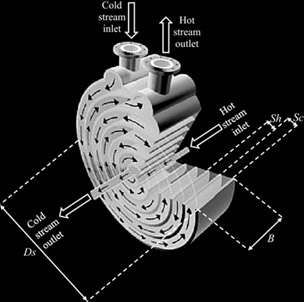Heat exchangers are a recent development in the history of mechanical inventions, they first appeared within the food processing industry during the 1920s. Through an international combination of efforts, largely between Sweden, the United Kingdom and China, the heat exchanger improved its functionality to grow and become the useful piece of equipment that it is today.
In this article we are going to lay out a Heat Exchanger Buyer’s Guide through a presentation that surrounds the basics of how heat exchangers function, some handy tips and tricks to reflect upon and what to look for when searching for used heat exchangers for sale.
Most Popular Types of Heat Exchangers:
The four most popular and common types of heat exchangers found at Surplus Record are the Plate Heat Exchangers, Shell and Tube Heat Exchangers, Air Cooled Heat Exchangers and the Spiral Heat Exchanger which are pictured below.
These 4 types Heat Exchangers all operate with the same objective, to transfer heat from one medium to another (think of them as an industrial heater or cooler with purpose). However, they vary with their range of usefulness from job to job. Understanding which exchanger is more practical for your specific task will assist you with the process of searching for the best used heat exchangers for sale.
Plate Heat Exchangers
The Plate Heat Exchanger functions like all other types of heat exchangers. A hot or cold fluid (either liquid or gas) is passed through a second fluid, without making contact, to induce heating or cooling upon the second fluid. Where the plate heat exchanger is different from other exchangers is found in the way that it is designed. The secondary fluid to be heated travels between a series of evenly spaced and stacked plates that are made of steel. From these plates, the heat is transferred to the secondary fluid which completes the process. The biggest advantage of using plates as the heat source is that the heat produced is evenly distributed over the secondary fluid allowing for maximum heating efficiency and productivity. Try viewing our catalog of used carbon steel heat exchangers for sale and used plate heat exchangers for sale.

Shell and Tube Heat Exchangers
Found within a stainless steel cylinder are a large number of small tubes which act as the heat producer of the exchanger. The hot primary fluid is inside these tubes and heats the tube which then shares its heat with the secondary fluid found between the tube and cylinder shell. These tubes are found together in bundles within the cylinder and prove to be highly efficient with the task of transferring heat. Cleaning and maintaining Shell and Tube Heat Exchangers is very easy due to their compact size and simplified design when compared to other exchangers. They also prove to be the most versatile of all of the heat exchangers as they can be used to produce a range of specific temperatures (hot and cold) and to varying pressures as required. View our used shell and tube heat exchangers for sale and stainless steel heat exchangers for sale. These include the following types:
- Carbon Steel Shell / Stainless Steel Tubes
- Carbon Steel Shell / Carbon Steel Tubes
- Carbon Steel Shell / Copper-Nickel Tubes
- Carbon Steel Shell / Hastelloy, Karbate, Monel, Titanium Tubes
- Karbate Shell / Karbate Tubes- Glass Lined
- Stainless Steel Shell / Stainless Steel Tubes
- Stainless Steel Shell / Hastelloy Tubes

Air Cooled Heat Exchangers
The name describes the Air Cooled Heat Exchanger well, its primary function is to “reject” excess heat from components and release the excess into the atmosphere. The hot primary fluid passes through tubes while air is projected upon the tubes by fans attached to the exchanger. This cools the liquid inside the tubes and is effective to use upon any liquid or chemical present inside the series of tubes. Compared to other forms of cooling equipment, the air cooled heat exchanger is extraordinarily budget friendly and waste free. It is also an easy exchanger to maintain as a result of its simple design. View our wide range of used heat exchangers for sale.

Spiral Heat Exchanger
A Spiral Heat Exchanger functions within the housing of a steel cylinder. Inside the cylinder you’ll find a continuous length of steel plates which are the width of the cylinder body. These plates form a spiral which is divided into two separate passages; one of these passages contains the primary heating liquid and the other contains the secondary fluid (to be heated). The fluids, as per normal, cannot come into contact with one another as they are housed in separate spiral passages. Imagine we begin from the outer passage of the spiral with the secondary liquid passage, primary liquid passage, secondary, primary and repeating all the way to the spiral’s center. This allows for the primary liquid to heat the secondary liquid from both sides and from all surface points.
The benefit of this advanced system is an increased rate of thermal conductivity, which is on average 50-100% greater than that of the shell and tube exchanger. Thermal conductivity and heat transfer rates are this effective because of the large surface area of the internal spiral and the layers of passages. Spiral Heat Exchangers are generally very easy to keep clean internally as the curvature of the spirals induces “self-cleaning” and they require minimal space. Take a look through our available range of used heat exchangers for sale.

Uses and Applications
The basic purpose of heat exchangers is to heat a cooler fluid by utilizing the heat produced by a hotter fluid or vice versa and cool a hot fluid by using the heat from a cooler fluid.
This form of heat conduction is used for a variety of purposes throughout different industries and can be found easily within day-to-day life. For example, a heat exchanger could be used to produce heat for a swimming pool, a home, or to cool a car engine. From the industrial perspective you would expect to find heat exchangers working within the chemical industry, refrigeration industry, in food processing systems, at oil refineries, for power generation, at breweries, in the automotive industry and more.
What to Look for When Buying a Heat Exchanger?
Now that you have some understanding of what the differences between heat exchangers and their general purpose are, you may be asking yourself, what do I need to watch out for when purchasing a used heat exchanger? Skim through the notes below for more information:
Maintenance Costs
Take this into serious consideration as it will not only be necessary to pay for installation and operation, but also for regular maintenance too. Some models and systems may be initially expensive to install but then require less maintenance and care. Explore the options clearly before purchase and do the math!
Heat Output
How much heating (or cooling) output do you need to generate for your specific task? Do you want to heat your swimming pool or produce enough energy to maintain an industrial furnace for energy production? Both require a heat exchanger to complete the task but they need a different amount of heat to work effectively.
The History
To avoid purchasing a used heat exchanger which fails to function correctly, you should inquire about its history. Ask for a report on how often it was serviced and maintained, what its last primary function was, and if possible visually inspect the exchanger for signs of wear and tear and for smooth operation.
Material of Fabrication
Heat exchangers can be found fabricated from a range of different materials and with different purposes. Plastic heat exchangers are available at a fraction of the cost of others but do not function so well under heavy load. Steel heat exchangers are more middle range and commonly sought after for their durable and functional abilities under applied pressure. While a granite heat exchanger may be more costly, it is well suited to corrosion resistance and high levels of thermal conductivity output.
Determine Your Specs
It is important to understand and determine the square footage/size, and horsepower specifications of the specific piece of equipment you need. All of Surplus Record’s listings of Heat Exchangers are listed in order from lowest square footage to highest.
Useful Accessories and Equipment
Heat exchanger accessories are plentiful and depending on your personal requirements you may benefit. Below are some of our most recommended accessories:
- Insulation: certainly not a requirement, however for owners looking to make the most of their exchanger this could be a viable option to save on heat loss.
- Wall mount: for many the best location to place your exchanger is on the wall out of the way of passage.
- Spare Parts: you will need to maintain your heat exchanger from time to time and by having an array of useful spare parts available you’ll never be stuck with a nonfunctional machine.
- Heat monitoring equipment: highly practical when wishing to test or review the heat conductivity of your exchanger.
Surplus Record: Tips and Tricks
To assist in your search for used heat exchangers for sale on our platform, we have attached some of our best tips and tricks to make finding your optimal heat exchanger a little bit easier.
- Make use of our Location Settings: At the top of the page, when on the list for your desired piece of equipment/machinery, enter your desired location and you’ll be taken directly to what we have available in your area.
- Looking for an Auction?: On the listing page, select the blue checkbox on your right which says “Auction” and you shall be taken to our available products for sale that are on auction.
- On a Budget?: Select the toggle “Sort by Relevance” and then click “Price low to high” to view our cheapest to most expensive products for sale.
- Don’t forget the Search Bar: Already know what you are looking for? Utilize our search tab at the top of your page to find specific listings out of hundreds available.
Quick Access: Heat Exchanger Dealers
- Louisiana Chemical Equipment Co. | Louisiana
- Plantex | Texas
- Federal Equipment Co. | Ohio
- US Combustion Products Co. | Idaho
At Surplus Record, we understand that the process of searching through buy and sell heat exchanger pages can be quite daunting. Our advice is to take your time, do your research and use this heat exchanger buying guide and the process of finding the optimal used heat exchanger for sale will be straightforward. Almost easy!
Quick Access: Heat Exchanger Manufacturers
Our top manufactures available on Surplus Record for used Heat Exchangers include:
Plate Heat Exchangers
Steel and Tube Heat Exchangers
Air Cooler Heat Exchangers
Spiral Heat Exchangers
Need More Help? or information about Heat Exchangers? Still can’t find what you’re looking for or need more advice from a professional dealer? Head on over to the “Wanteds” section of our website and select “Buy” at the top and “Processing Equipment” for the industry. Fill out the form and a dealer that specializes in heat exchanger machinery will get back to you ASAP. It’s free to do, and our dealers are happy to help out!

